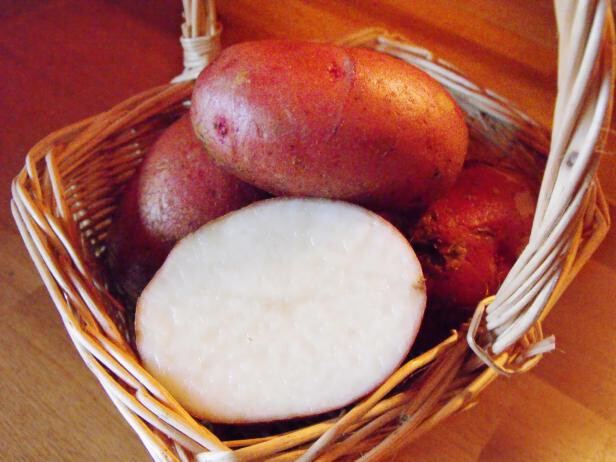Red potatoes, the most common variety of potatoes in the United States, have red skin and white flesh. Because they are typically small and roundish, they are sometimes called “new” potatoes, which are actually the young, immature tubers harvested early from any potato variety. In spite of their small size, they remain firm and moist when cooked, and their very thin skin does not need peeling before cooking or eating. They are excellent when boiled, steamed or roasted.
Red Potato Varieties
·Red Pontiac is a very popular mid-season potato that is generally round to slightly oblong.
·Norland Red holds up very well when cooked.
·Red Gold has reddish skin and golden-colored flesh.
·Red LaSoda and LaRouge are red-skin potatoes that grow well and mature fairly early — important in warmer climates where cool seasons are short.
·Red Ruby is an early-maturing, brilliant red skin potato that stores very well.
·The heavy-producing All Red has brilliant red skin and light red flesh.
Growing Red Potatoes
Red potato plants need seven or eight hours of sunshine, well-drained moist soil and good fertility. Plant potatoes during cool weather when there is no danger of a freeze but when temperatures remain below the mid-80s Fahrenheit.
Find “seed” potatoes online, but order early while supplies last. Before planting, cut seed potatoes into small pieces, each with one or two small “eyes” or leaf buds. Plant about 3 inches deep and 1 foot apart in rows, hills, raised beds or containers. Apply an all-purpose fertilizer before planting, and an extra bit about a month after plants start growing.
Potato tubers grow on short stolons on lower stems. To avoid tuber greening and a buildup of a poisonous plant alkaloid called solanine, keep tubers in total darkness by piling soil or thick mulch around small plants, repeating as needed until 6 or 8 inches of lower stems are buried.

Harvesting Potatoes
Tiny, extra-tender baby red potatoes can be harvested about three months after planting, but for somewhat larger, mature tubers, wait another month or so when plants begin to turn yellow. Because of their thin, delicate skins, dig carefully to avoid cuts and bruises – just gently dust off the soil, and do not wash, as this can lead to decay.
Store mature tubers in a cool, dry, dark area such as the refrigerator, for a few weeks, checking regularly for shriveling and decay. Because of their thin skin, red potatoes do not store well and are best cooked rather quickly after harvest.